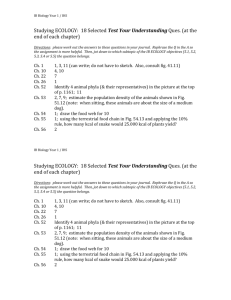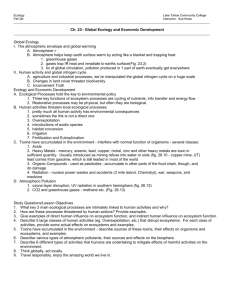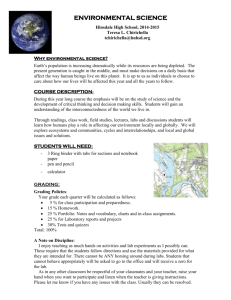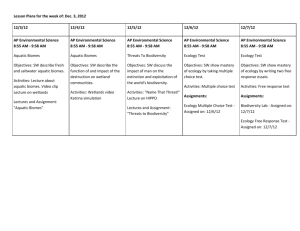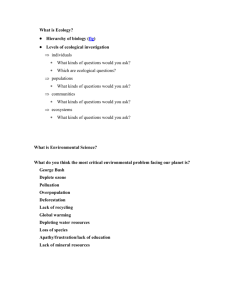Organismal Biology Study Guide for Test # 4 (4 MAY 2005 – Wed)
advertisement
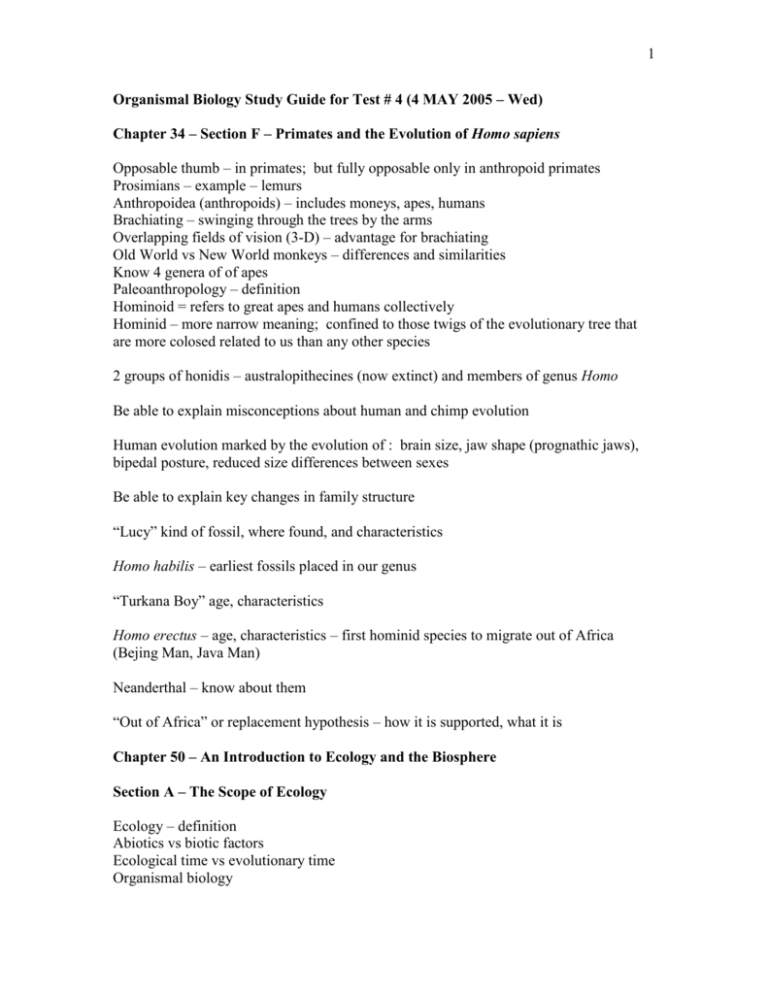
1 Organismal Biology Study Guide for Test # 4 (4 MAY 2005 – Wed) Chapter 34 – Section F – Primates and the Evolution of Homo sapiens Opposable thumb – in primates; but fully opposable only in anthropoid primates Prosimians – example – lemurs Anthropoidea (anthropoids) – includes moneys, apes, humans Brachiating – swinging through the trees by the arms Overlapping fields of vision (3-D) – advantage for brachiating Old World vs New World monkeys – differences and similarities Know 4 genera of of apes Paleoanthropology – definition Hominoid = refers to great apes and humans collectively Hominid – more narrow meaning; confined to those twigs of the evolutionary tree that are more colosed related to us than any other species 2 groups of honidis – australopithecines (now extinct) and members of genus Homo Be able to explain misconceptions about human and chimp evolution Human evolution marked by the evolution of : brain size, jaw shape (prognathic jaws), bipedal posture, reduced size differences between sexes Be able to explain key changes in family structure “Lucy” kind of fossil, where found, and characteristics Homo habilis – earliest fossils placed in our genus “Turkana Boy” age, characteristics Homo erectus – age, characteristics – first hominid species to migrate out of Africa (Bejing Man, Java Man) Neanderthal – know about them “Out of Africa” or replacement hypothesis – how it is supported, what it is Chapter 50 – An Introduction to Ecology and the Biosphere Section A – The Scope of Ecology Ecology – definition Abiotics vs biotic factors Ecological time vs evolutionary time Organismal biology 2 Organism – population – community – ecosystem Community ecology Ecosystem ecology Landscape ecology Rachel Carson – DDT – wrote book “Silent Spring” – know her story Section B1 – Factors Affecting the Distribution of Organisms Global patterns in distribution of organisms (know names and locations of Neotropical, etc) Biogeography Dispersal, transplants Introduced species – e.g., Africanized bees, zebra mussels, etc. Limpet/sea urchin experiment – to determine effect of predation on seaweed Examples of abiotic factors Section B2 – Factors Affecting the Distribution of Organisms (continued) Climate - definition Climate and biomes Be able to interpret and know main concepts demonstrated in Fig 50.10, 50.11, 50.12 Equinox Water air rises, as it cools, precipitation falls Main direction of weather patterns in US ;What happens as warm air rises and goes over mountain chains Know Fig. 50.15 very well – terms and concepts Microclimates Global climate and global warming – what effects this could have on species distribution Section C1 – Aquatic and Terrestrial Biomes Marine biomes and their main characteristics Photic zone, aphotic zone, thermocline, benthic zone (Fig. 50.18) Littoral zone, limnetic zone, profundal zone Oligotrophic, eutrophic, and mesotrophic lakes – know the differences Oxbow rivers and streams Problems with damming 3 Wetlands Estuaries Be able to explain (and know names of) zones in marine environment – Fig. 50.22 Coral reefs Ocean pelagic biome Benthos Abyssal zone Section C2 - Aquatic and Terrestrial Biomes (continued) Know main biomes and their main characteristics (e.g., savannas, deserts, chaparrals, temperate grasslands, temperate deciduous forests, coniferous forests, tundra Abiotic factors vs biotic factors Vertical stratification Canopy Permafrost Section D – The Spatial Scale of Distributions Know various kinds of scales – see Fig. 50.26 Chapter 51 – Behavioral Ecology Section A – Introduction to Behavior and Behavioral Ecology Behavior – definition Proximate vs ultimate causes – what each is Nature-vs-nature – in behavior, BOTH are involved – understand example given by 51.1 Innate behavior – due to genetic programming Ethology Understand experiment in Fig 51.12 and what concept it is demonstrating FAP = fixed action patterns ; and sign stimulus – definitions and examples (color red in sticklebacks) Behavioral ecology – definition Be able to interpret Figs. 51.5, 51.6, 51.7, and Table on page 1127 Section B – Learning Learning – definition Learning vs maturation Habituation – definition and examples Imprinting – definition and examples Konrad Lorenz and his famous imprinting experiments Sensitive period 4 bird song- genetic and learning components associative learning, classical conditioning (Pavlov’s dog) operant conditioning – definition and examples importance of play behavior Section C – Animal Cognition Cognition – definition Kinesis vs taxis and examples of each Confitive maps Migration Piloting, orientation, navigation Section D1 – Social Behavior and Sociobiology Social behavior – definition Agonistic, submissive, ritualistic behaviors Reconciliation behavior Dominance hierarchies – alpha, beta, etc. – more than 1 kind of hierarchy (“pecking order”) Territory and territoriality – costs and benefits – how territory is marked Parental investment (usually more in females than males) Mating systems – know the differences and an example of each – promiscuous, monogamous, polygamous, polygyny, polyandry Certainty of paternity – male investment is usually higher Section D2 - Social Behavior and Sociobiology (continued) Signal Communication Display Pheromones “Waggle dance” of the honeybee Altruism Kin selection Naked mole rats – truly social species; demonstrates kin selection Warning barks in ground squirrels Inclusive fitness Hamilton’s Rule and kin selection – understand the basic equation and ideas behind it to mathematically explain kin selection Reciprocal altruism Humans – part of learning is cultural – what we pass down to the next generation 5 Chapter 52 – Population Ecology Section A – Characteristics of Populations Population – definition and characteriscs ( like density, dispersion) Mark-recapture methods – how they work, why important Patterns of dispersion – clumped, random, uniform – why each might occur Demography Life table – main point of it Cohort Survivorship curves – Types I, II, III – characteristics and examples of each – Fig. 52.3 Reproductive tables – see Table52.2 Section B – Life Histories Life history Big-bang reproduction Semelpariety Repeated reproductive Iteroparity Tradeoffs between survival and reproduction – see Fig. 52.5 Quality vs quantify of offspring Section C – Population Growth Know and understand equations for population growth ZPG Exponential population growth – equation, graph, meaning, what kind of animals exhibit this kind of growth, what kind of conditions Carrying capacity (K) Logistic population growth - equation, graph, meaning, what kind of animals exhibit this kind of growth, what kind of conditions Fig. 52.11 – be able to interpret K-selection vs r-selection – what each is, characteristics of each, what animals represent each kind Section D – Population-Limiting Factors Densitiy-dependent factors and negative feedback Density-independent factors 6 Intraspecific competition – what it is, examples – territoriality, predation, waste accumulation (note wine example), disease Population fluctuations; snowshoe hare and lynx example Section E – Human Population Growth Human – so far, exponential growth Plague ZPG Demographic transition Age structure – see Fig. 52.22 – know graphs and meaning of each What is Earth’s carrying capacity? Ecological footprint – components of; be able to explain Fig. 52.23 Chapter 55 – Conservation Biology Section A – The Biodiversity Crisis 3 levels of biodiversity: genetic, species, and ecosystem – know what each is Endangered species, threatened species – definitions IUCN = International Union for the Conservation of Nature and Natural Resources – what this organization says Ways in which biodiversity at all levels is vital to human welfare – see page 1127 Major threats to biodiversity – habitat destruction, introduced species, overexploitation, and food chain disruptions Introduced species – some examples – pages 1229-1231

